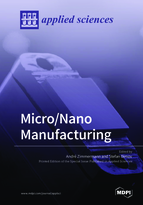Micro/Nano Manufacturing
A special issue of Applied Sciences (ISSN 2076-3417). This special issue belongs to the section "Mechanical Engineering".
Deadline for manuscript submissions: closed (31 March 2019) | Viewed by 69293
Special Issue Editors
Interests: microtechnology; micromanufacturing; nanomanufacturing; microsystems technology; system integration; electronic packaging; electronic assembly and interconnection technology; sensors; reliability
Special Issues, Collections and Topics in MDPI journals
Interests: micromanufacturing; microreplication; micromachining; laser microprocessing; additive manufacturing; process chain design; functional surface patterning/texturing; process integration; technology maturity assessment
Special Issues, Collections and Topics in MDPI journals
Special Issue Information
Dear Colleagues,
Micro manufacturing is dealing with the fabrication of structures in the order of 0.1 to 1000 µm. The scope of nano manufacturing extends the size range of manufactured features to even smaller length scales below 100 nm. A sharp borderline between micro and nano manufacturing can hardly be drawn, such that both domains are treated as complementary within a closely interconnected scientific community. Both micro and nano manufacturing can be considered as important enablers for high-end products. Especially, such products are enabled by micro and nano features and structures to incorporate special optical, electronic, mechanical, fluidic or biological functions in existing and new emerging products and thus lead to unique selling points. Application fields include, but are not restricted to, metrology, industrial technology, automotive technology, medical technology, and life sciences. This Special Issue is dedicated to recent advances in research and development within the field of micro and nano manufacturing. Therefore, papers are welcome that report recent findings and advances in manufacturing technologies for producing products with micro and nano scale features and structures. Furthermore, papers that report applications underpinned by such advances in micro and nano manufacturing technologies are also welcomed. In particular, the Special Issue intends to cover, but is not limited to, the following topics:
- Micro fabrication technologies, process chains and process characterisation;
- Novel product designs, micro-assembly technologies and micro-handling;
- Surface engineering and interface nanotechnology;
- Process modelling and simulation;
- Processing and characterisation of smart materials, multifunctional materials, nanomaterials and material related issues in micro and nano scale;
- Micro and nano additive manufacturing technologies;
- Micro and desktop factory concepts, systems, components and modules;
- On-line monitoring and inspection systems/methods;
- Standardization in micro manufacturing and micro factories;
- Applications of micro and nano technologies: microreactor technologies, microsensors and actuators
Prof. Dr. André Zimmermann
Prof. Dr. Stefan Dimov
Guest Editors
Manuscript Submission Information
Manuscripts should be submitted online at www.mdpi.com by registering and logging in to this website. Once you are registered, click here to go to the submission form. Manuscripts can be submitted until the deadline. All submissions that pass pre-check are peer-reviewed. Accepted papers will be published continuously in the journal (as soon as accepted) and will be listed together on the special issue website. Research articles, review articles as well as short communications are invited. For planned papers, a title and short abstract (about 100 words) can be sent to the Editorial Office for announcement on this website.
Submitted manuscripts should not have been published previously, nor be under consideration for publication elsewhere (except conference proceedings papers). All manuscripts are thoroughly refereed through a single-blind peer-review process. A guide for authors and other relevant information for submission of manuscripts is available on the Instructions for Authors page. Applied Sciences is an international peer-reviewed open access semimonthly journal published by MDPI.
Please visit the Instructions for Authors page before submitting a manuscript. The Article Processing Charge (APC) for publication in this open access journal is 2400 CHF (Swiss Francs). Submitted papers should be well formatted and use good English. Authors may use MDPI's English editing service prior to publication or during author revisions.
Keywords
- micro manufacturing
- nano manufacturing
- manufacturing technology
- micro structures
- nano structures
- microtechnology
- micromechanics
- microoptics
- microsystems technology
- sensor integration
- multi material manufacturing
- micro fabrication
- micro and nano additive manufacturing
- micro-assembly
- micro-handling
- surface engineering and interface nanotechnology
- standardization in micro manufacturing and micro factories
- micro and desktop factory concepts, systems, components and modules
- microreactors
- microsensors
- micro actuators







